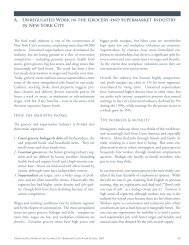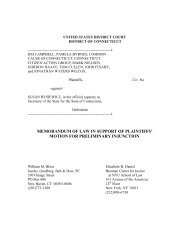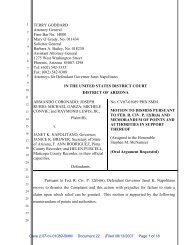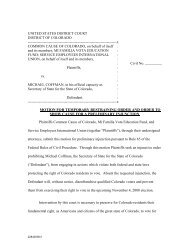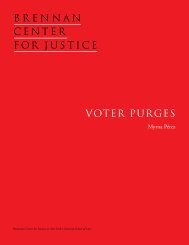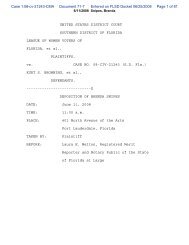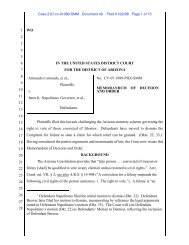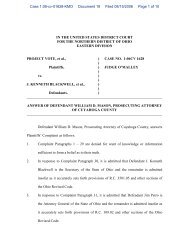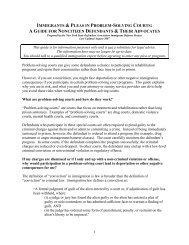Jim Crow in New York
Jim Crow in New York
Jim Crow in New York
You also want an ePaper? Increase the reach of your titles
YUMPU automatically turns print PDFs into web optimized ePapers that Google loves.
It is widely known and well documented that Americans used the law to<br />
keep African-American voters out of the electoral process throughout the<br />
Deep South. In the late 1800s, <strong>Jim</strong> <strong>Crow</strong> laws spread as part of a backlash<br />
aga<strong>in</strong>st the Reconstruction Amendments – the Thirteenth, Fourteenth,<br />
and Fifteenth Amendments of the U.S. Constitution – which<br />
ended slavery, granted equal citizenship to freed slaves, and prohibited<br />
racial discrim<strong>in</strong>ation <strong>in</strong> vot<strong>in</strong>g. 1 The uproar worked its <strong>in</strong>tended purpose:<br />
large segments of the African-American population were effectively<br />
removed from the democratic process for susta<strong>in</strong>ed periods, <strong>in</strong> some cases<br />
for life. 2<br />
Less known is that crim<strong>in</strong>al disenfranchisement laws were part of the<br />
effort to ma<strong>in</strong>ta<strong>in</strong> white control over access to the polls. 3 Between 1865<br />
and 1900, a period when African-American men were, theoretically,<br />
granted greater vot<strong>in</strong>g rights state-by-state, and ultimately enfranchised<br />
by the Fifteenth Amendment, 19 states passed crim<strong>in</strong>al disenfranchisement<br />
laws. By 1900, 38 states deployed some type of crim<strong>in</strong>al vot<strong>in</strong>g<br />
restriction. 4 These laws disenfranchised convicted <strong>in</strong>dividuals long after<br />
their release from prison; many dictated that <strong>in</strong>dividuals released from<br />
prison could not vote unless they had been pardoned by the governor. 5<br />
<strong>Jim</strong> <strong>Crow</strong> laws<br />
worked their <strong>in</strong>tended<br />
purpose: large<br />
segments of the<br />
African-American<br />
population were<br />
effectively removed<br />
from the democratic<br />
process for susta<strong>in</strong>ed<br />
periods – <strong>in</strong> some<br />
cases for life.<br />
States also adapted their crim<strong>in</strong>al codes to punish those offenses with<br />
which they believed freedmen were likely to be charged, <strong>in</strong>clud<strong>in</strong>g bigamy,<br />
vagrancy, petty theft and burglary. 6 Together, targeted crim<strong>in</strong>alization<br />
and felony disenfranchisement stripped African Americans of their<br />
vot<strong>in</strong>g rights – and suppressed African American’s political power for<br />
decades. 7 The discrim<strong>in</strong>atory impact of these laws and practices cont<strong>in</strong>ues<br />
to this day. Nationwide, 8% of the African-American population, or<br />
2,000,000 African Americans, are disenfranchised. 8 Given current rates<br />
of <strong>in</strong>carceration, approximately one <strong>in</strong> three of the next generation of<br />
black men will be disenfranchised at some po<strong>in</strong>t dur<strong>in</strong>g their lifetime.<br />
But <strong>Jim</strong> <strong>Crow</strong> was not conf<strong>in</strong>ed to the South. He made his home <strong>in</strong><br />
northern states as well, perhaps most notably <strong>in</strong> <strong>New</strong> <strong>York</strong>. Start<strong>in</strong>g <strong>in</strong><br />
the 18th century, the history of <strong>New</strong> <strong>York</strong>’s election laws follows this<br />
national narrative. In fact, <strong>New</strong> <strong>York</strong> was the only state <strong>in</strong> the country<br />
to require blacks – and only blacks – to own real property <strong>in</strong> order to<br />
qualify to vote.<br />
<strong>Jim</strong> <strong>Crow</strong> was not<br />
confi ned to the South.<br />
<strong>New</strong> <strong>York</strong>’s crim<strong>in</strong>al disenfranchisement provisions, like those deployed<br />
<strong>in</strong> the South, were part of a concerted effort to exclude African Americans<br />
from participat<strong>in</strong>g <strong>in</strong> the political process. As African Americans<br />
ga<strong>in</strong>ed freedom with the gradual end of slavery, <strong>New</strong> <strong>York</strong>’s vot<strong>in</strong>g qualifications<br />
– <strong>in</strong>clud<strong>in</strong>g crim<strong>in</strong>al disenfranchisement laws – became <strong>in</strong>creas<strong>in</strong>gly<br />
more restrictive. A careful read<strong>in</strong>g of <strong>New</strong> <strong>York</strong>’s constitutional<br />
history reveals that at the very time that the Fourteenth and Fifteenth<br />
<strong>Jim</strong> <strong>Crow</strong> <strong>in</strong> <strong>New</strong> <strong>York</strong><br />
4



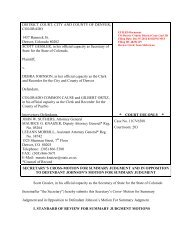
![Download the Letter [PDF] - Brennan Center for Justice](https://img.yumpu.com/50139248/1/190x245/download-the-letter-pdf-brennan-center-for-justice.jpg?quality=85)
